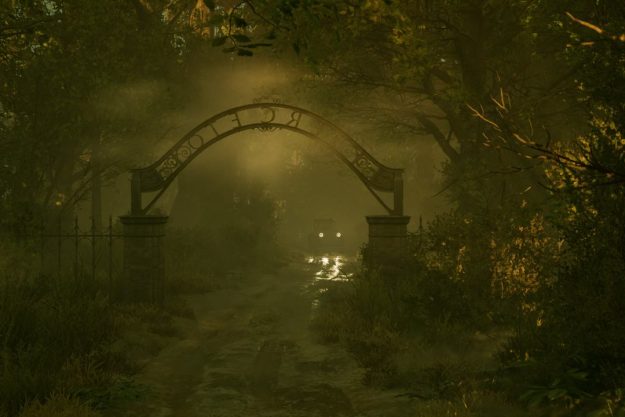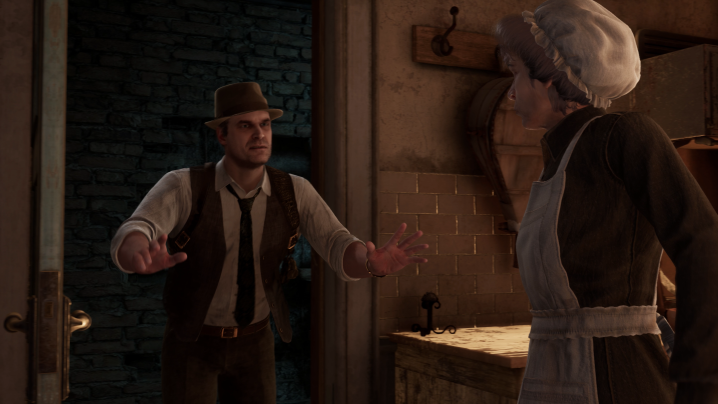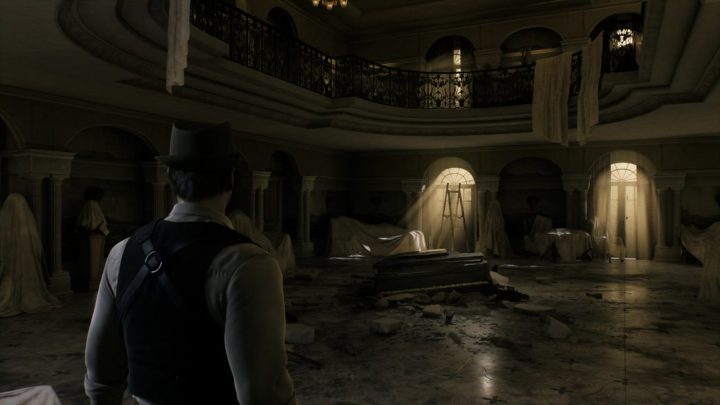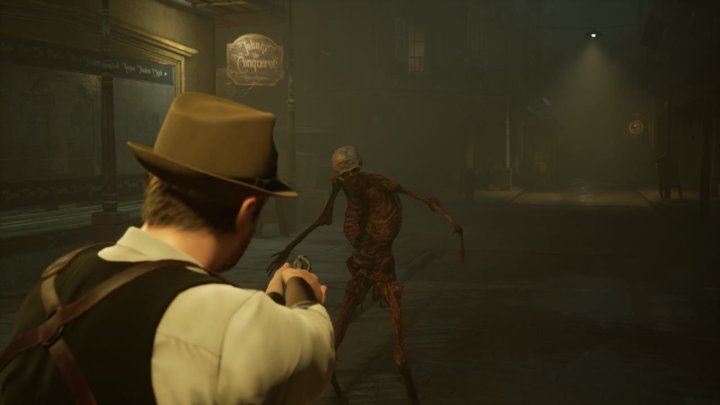
“Alone in the Dark is the confidently silly horror remake the 1992 classic deserves.”
- Delightfully hammy voice acting
- Space-bending environments
- Jazzy score is a welcome throwback
- Classic exploration hook
- Useful difficulty tools
- Flat story
- Clumsy combat
- Unmemorable monsters
As I rolled the end credits on Alone in the Dark, the new remake of a foundational 1992 horror classic, I watched on like a puzzled detective. It’s not that I didn’t enjoy my stay in the creepy Derceto Manor. Quite the contrary — I had enjoyed the campy six-hour adventure filled with hammy voice acting and old-school exploration. It felt like a fitting throwback, capturing the endearing sloppiness of 1990s games in a big-budget modern production. But there was one question remaining: Was that developer Pieces Interactive’s intent, or a happy accident born from a clumsy game with an unconvincing serious face?
I’d have my eureka moment as soon as I began my second playthrough. After choosing my hero, the Jodie Comer-voiced Emily Hartwood, I popped into the settings menu to toy around with some of the remake’s bonus features. There, I’d find a Bonus menu. I’d enable an 8-bit filter and a skin for Hartwood that turned her into a blocky mess of polygons pulled right from the 1992 game. As soon as I unpaused, I laughed out loud at the absurd sight of it all.
It was the missing piece of the puzzle. Everything that one might call “outdated” was indeed the point; I had just played an unabashedly sincere ode to 1990s silliness.
Alone in the Dark’s clumsy action and boilerplate occult story may be off-putting to new players hoping for a Resident Evil-like glow-up. Meet the remake on its own terms, though, and you’ll find a charming ’90s horror homage that doesn’t turn its nose up at gaming’s roots. It revels in its old-school design like a dedicated cultist, even inviting Hollywood actors to dance around the fire with it.
Return to Derceto
Alone in the Dark is a full remake of the 1992 horror classic of the same name (not to be confused with the much less successful 2008 reboot with the same title). It’s a significant reimagining, trading in fixed camera angles and tank controls for a more traditional third-person survival horror format with a greater emphasis on shooting. Though that may sound like a big change, Pieces Interactive retains the energy of the eclectic original, even when inserting modern twists.

While the story has been expanded with cutscenes, it’s certainly not trying to elevate its source material all too high. The Louisiana-set horror game follows Emily Hartwood, who heads out to the eerie Derceto Manor alongside detective Edward Carnby in search of her missing uncle. That simple setup gives birth to a simmering occult narrative that builds throughout. It’s not the most exciting or fresh tale, with a lot of worldbuilding happening in dull lore logs, but that seems to be by design. The original Alone in the Dark set the stage for what would become an overused haunted house trope. You don’t get Resident Evil without it, and Pieces Interactive doesn’t obscure that with a fancier story.
In fact, it delights in the hamminess of that premise. Every lore log comes accompanied with an overacted audio reading that sells the silliness. Every voice actor seems to understand the assignment here, and that includes its A-list actors. Killing Eve star Jodie Comer and Stranger Things’ David Harbour both turn in fitting performances that call back to the stilted nature of ’90s video game voice acting rather than trying to one-up it. Harbour especially hams it up as Edward with the old-timey drawl of a classic noir hero.
It’s a time capsule that’s an off-kilter delight to open.
The visual overhaul isn’t as striking as its predecessor, a game that’s instantly recognizable for its otherworldly colors and polygons. Pieces Interactive opts for an understandably modern look that paints the manor in a more dryly realistic manor. The studio does, however, get to have fun with more capable tech. The mansion is reimagined as a liminal space, with story sequences that seamlessly morph its shifting hallways. One moment, Edward might open a door, only to be hit with a quick jump scare as he suddenly finds himself stepping into a vine-covered train car or an arctic tundra. That visual creativity gives the remake its own playful touch that makes the haunted house feel like more of a living threat.
However, it’s the moments that call back to the ’90s that stick with me most after playing. Chief among them is the remake’s score, full of cheesy doom jazz that feels like it was plucked from an old game of the era. That decision keeps the tone of Alone in the Dark firmly in place rather than washing it out with the ambient eeriness of its peers. It’s a time capsule that’s an off-kilter delight to open.
Old-school puzzling
What’s a little more hit-and-miss is the gameplay itself, which finds itself more torn between modern and classic design ideas. It’s not too different from games like the recent Resident Evil remake, with homogenized action-adventure hooks. Players explore a compact puzzle box mansion, picking up items, unlocking new rooms, and shooting down the occasional monster. It’s not the most inventive formula, but it still feels like a logical evolution of the original game.
On the bright side of the spectrum, exploration and puzzl- solving both carry a retro charm. Players mostly move from room to room grabbing keys, notes, and objects that need to be slotted into the right place. There’s a simple pleasure to that format, which is perhaps why it’s so enduring. When I find a metal cutout of France, I’m delighted when I find a globe I can pop it into, which cracks it open and reveals my next clue. The mansion is one big scavenger hunt that chains to the end of the story.

The original Alone in the Dark was especially obtuse about its puzzles, forcing players to carefully read notes and interact with the world in an almost point-and-click manner. For players who want that experience, the remake offers it with customizable puzzle difficulty. Purists can turn clues and map markers off entirely, forcing them to carefully read through notes to discern hidden clues. For those who don’t have the patience, though, a modern mode highlights every important detail and fills the map up with the location of locked doors and puzzles. It’s a great compromise; I even tried it both ways since Alone in the Dark is meant to be beaten with each character, whose paths diverge.
The power of that change became clear to me when using my Talisman, an iconic tool that’s used here to find hidden doors with rotating number dials. When I played with all the guidance on, I simply had to find three-digit codes that were often highlighted in my notes and input them into my talisman. When I turned everything off, I had to search harder for those solutions and even figure out how the mechanism itself actually works without number boxes to guide me. The fact that I could toggle hints on and off as I needed them allowed me to enjoy the classic experience while avoiding the eventual frustrations of overly hidden solutions.
Struggling with action
What’s less successful here is the remake’s almost obligatory third-person shooting. Edward and Emily get a small handful of weapons throughout their stories, from pistols to tommy guns. Rather than loading rooms up with tons of enemies to gun down, Alone in the Dark dishes out more focused action interludes between its freeform exploration segments. That restraint is a blessing in disguise, as combat is its fleshy weak point.
Shooting feels more like a half-hearted obligation to keep modern players entertained.
The systems aren’t very complicated; it’s a simple aim-and-shoot system with some minor twists. Objects, like bricks and Molotov cocktails, can be tossed at enemies, and there’s some light sneaking involved in a few stealthy sections. Nothing feels quite developed though, which often making shootouts feel sloppy. Melee weapons have a short range and don’t lock on to enemies terribly well. Whenever I’d try to use one, I’d just end up swinging wildly while a creep backed me into a wall and stunlocked me to death. Though there are tons of different weapons to pick up, from axes to boat oars, they all function about the same.
There’s not much enemy variety that calls for decision-making either. Most enemies are shambling zombies that go down in a few shots regardless of where you hit them. Some pesky flying bugs pop up near the end, but the remake lacks in memorable monster designs outside of one gooey final boss. Shooting feels more like a half-hearted obligation to entertain modern players who don’t have a lot of patience for reading-heavy puzzles.

Though that aspect underwhelms, I appreciate how Pieces Interactive didn’t go overboard in crafting a complex action system full of complicated melee animations and craftable death traps. There’s something old school about how simplistic it all is, with its small arsenal of basic guns and minimal combat encounters. One easy climactic battle simply has me unloading machine gun rounds into a slowly lurching enemy, knocking him down so I can walk over and jab a dagger into him three times. It has the straightforward design of a Silent Hill 2 boss fight, adding to the underlying retro feel under its new-age visuals.
The real joy of Alone in the Dark comes from seeing a developer that admires gaming history embracing classic design that today’s audience might call dated or clunky. This isn’t a project that feels it needs to paint over the past to turn the series into something it never was (see the critically maligned 2008 reboot to see how that hubris turned out). Instead, it reminds us that a goofy haunted house story has its place in 2024 right alongside glitzy open-world games chasing a pricey Hollywood ideal.
Reject modernity; embrace tradition.
Alone in the Dark was tested on PC and Steam Deck OLED.
Editors' Recommendations
- Alone in the Dark: release date, trailers, gameplay, and more
- Alone in the Dark launches in October, and a free prologue is available now
- Alone in the Dark is getting a Resident Evil 2-esque reboot




